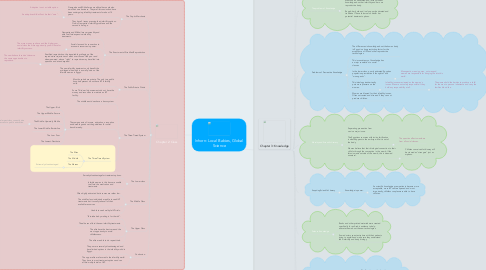
1. Chapter 2: Class
1.1. The Coptic Merchants
1.1.1. Georgette and Mikhail are a wealthy elite couple who own their own business. They are first cousins and have been undergoing infertility treatments for about 14 years.
1.1.1.1. Adoption is not a viable option.
1.1.1.2. An adoptive child will not be their "own".
1.1.2. They have 2 issues pressing their infertility options. One is Georgette's infertility problems and the second is her age.
1.2. The Enactment of Stratified Reproduction
1.2.1. Georgette and Mikhail are very wealthy and able to afford expensive infertility treatments.
1.2.2. Social class and its connection to economic resources is power.
1.2.2.1. The more money you have and the higher your social class the more opportunity you will have for infertility success.
1.2.3. Stratified reproduction: the inequitable privileging of the reproductive trajectories of elites over those of the poor and disempowered, whose "right" to reproduce may be called into question and even despised.
1.2.3.1. Those who have less don't deserve the same opportunities to reproduce.
1.2.4. The new infertility treatments only benefit the privileged elite which is a small portion of the infertile women in Egypt.
1.3. The Public-Private Divide
1.3.1. Most hospitals are private. The only two public hospitals present do not have IVF infertility units.
1.3.2. Some Third world governments do not have the money and resources to maintain an IVF facility.
1.4. The Three-Tiered System
1.4.1. The middle east does have a class system.
1.4.2. The components of income, education, occupation and durable goods set the guidelines for social class hierarchy.
1.4.2.1. The Upper: Rich
1.4.2.2. The Upper-Middle: Secure
1.4.2.3. The Middle: Upwardly Mobile
1.4.2.3.1. The largest class currently due to access to public education.
1.4.2.4. The Lower Middle: Borderline
1.4.2.5. The Low: Poor
1.4.2.6. The Lowest: Destitute
1.4.3. The Three Tiered System
1.4.3.1. The Elites
1.4.3.2. The Middle
1.4.3.3. The Masses
1.4.3.3.1. Extremely disadvantaged
1.5. The Lower class
1.5.1. Serverly disadvantage for treatment options.
1.5.2. Infertile women in this class are unable to afford the medication and treatments.
1.6. The Middle Class
1.6.1. Often highly educated but incomes are rather low.
1.6.2. The middle class individuals are able to seek IVF treatments but it usually takes all of their available resources.
1.6.3. Unable to seek multiple IVF trials.
1.7. The Upper Class
1.7.1. "Test-tube baby making is for the rich".
1.7.2. The elite can afford the new infertility treatments.
1.7.3. The elite have the best care and the most opportunity to avoid childlessness.
1.7.4. The elite are able to do repeat trials.
1.8. Conclusion:
1.8.1. The poor are severely disadvantaged and have limited options in the infertility world in Egypt.
1.8.2. The upper elite are favored in the infertility world. They have to most treatment options and can afford multiple trials of IVF.
2. Chapter 3: Knowledge
2.1. The Oasis Dwellers
2.1.1. Mabruka has been married to Ragab for 5 years without any children.
2.1.2. Her husband and his family have put great pressure on her to have a child.
2.1.3. Mabruka has been seeking infertility treatments. She refers to her husband as "locked brain" because he is uneducated and closed minded about utilizing treatments especially IVF.
2.1.4. Her husband has allowed AIH but will not allow IVF treatment regardless of the technologies and safety precautions in fear of "mixing" his sperm with someone else's.
2.2. The problem of Knowledge
2.2.1. Mabruka is uneducated and lacks sufficient knowledge about her infertility and her own reproductive body.
2.2.2. Ragab, her husband, is also poorly educated and traditional. These factors also hinder her potential treatment options.
2.3. Problems of Procreative Knowledge
2.3.1. The differences in knowledge about the human body in Egypt is a huge restricting factor for the acceptance of IVF and other reproductive technologies.
2.3.2. This inconsistency of knowledge has a major correlation to social classes.
2.3.3. In the lower class, poorly educated Egyptian population procreation is thought of as a "monogentic".
2.3.3.1. Monogentic, meaning men, not men and women are responsible for bringing life into this world.
2.3.4. This ideology inadvertently puts more pressure on the women.
2.3.4.1. Infertility issues are viewed as the woman's issues. Men are not solely responsible if they hold any responsibility at all.
2.3.4.1.1. The women hold the burden to produce a child for the man to pass on inheritance and carry the families blood line.
2.3.5. Woman are blamed for their infertility issues. Often outcasted and divorced if they can not produce children.
2.4. Morality and Scientific Literacy
2.4.1. Separating procreation from sex is a major issue.
2.4.2. The Egyptians concerns with invitro fertilization is what happens to the embryo while it is out of the body.
2.4.2.1. The question affects members from all social classes.
2.4.3. Women believe that their biological connection to their child is through the conception in the womb. If the fetus is made outside of the womb, this is deemed unnatural.
2.4.3.1. Children conceived in this way will be viewed as "strangers" just as orphans.
2.5. Acquiring Scientific Literacy
2.5.1. Knowledge is power.
2.5.1.1. As scientific knowledge grew, patients became more acceptable, more IVF centers opened and most importantly, childless couples were able to have children.
2.6. Paths to Knowledge
2.6.1. Books and other printed materials were created specifically for an Arabic audience to help educate them about the new technologies.
2.6.2. Some doctors spent extra time with their patients trying to explain and make sure they understand their infertility and body biology.
2.7. Scientific Literacy in a Mass-Mediated Society
2.7.1. The Egyptian media played a gigantic role in the shift in education in Egypt.
2.7.2. The medias, news coverage, movies and commercials invited the "new technologies" involving infertility into the lives of Egyptians.
2.8. Conclusion: The Desire for Knowledge
2.8.1. Muslims believe that God gives humans the knowledge to overcome their problems.
2.8.2. The illiterate, poor lower class are at a disadvantage in comparison to the middle and upper classes who suffer from infertility.
2.8.3. Knowledge is power and extremely necessary to understand infertility treatment options and diagnosis.
